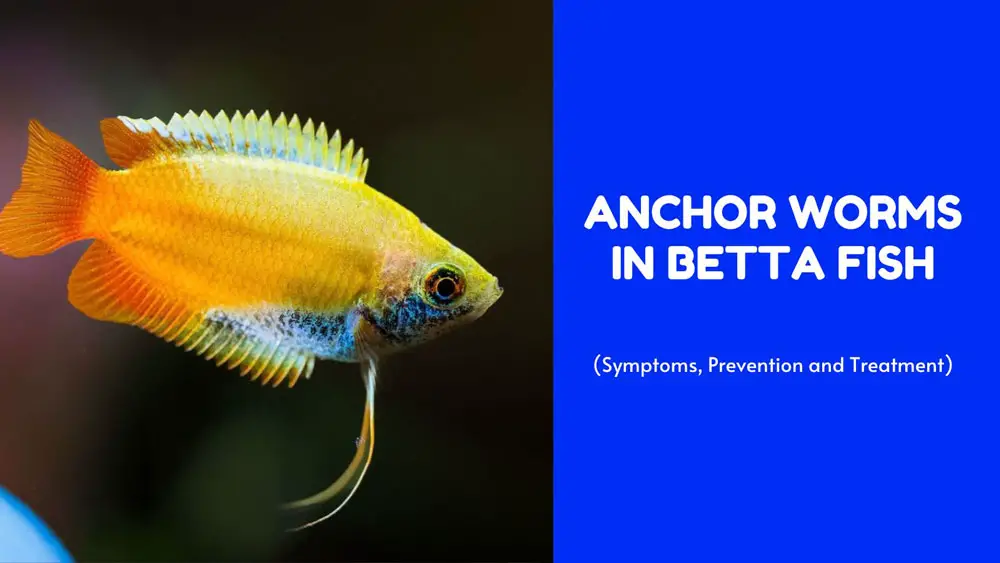10-gallon fish tanks have a great appeal among first-time aquarium owners because they are small enough to be placed securely on anywhere.
However, contrary to what you might think, small tanks are actually not recommended for new hobbyists since they are far more difficult to manage than medium ones.
If you’ve just invested in a 10 gallons aquarium and you’re looking for a colorful or unusual-looking centerpiece fish that really stands out, take a look at the most popular ones available.
Honey Gourami (Trichogaster chuna)
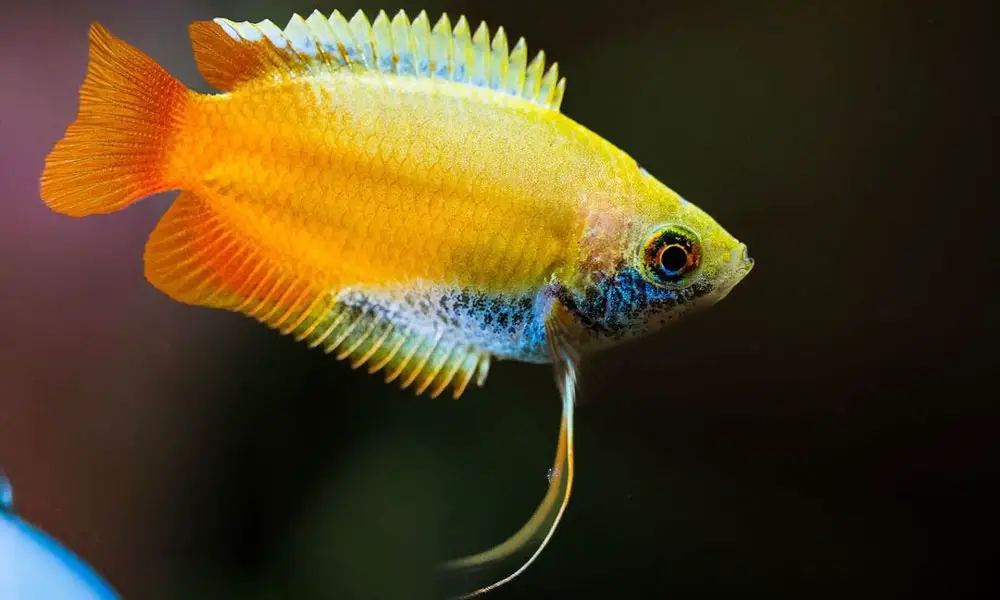
Gouramis have been in the freshwater aquarium trade for a long time and are one of the most diverse families. Most gouramis are medium-sized tropical fish, but the honey gourami (Trichogaster chuna) is smaller in size and can only grow up to about 2 inches (5 cm) long when fully grown.
These brightly colored fish are native to lakes and rivers in India and Bangladesh. In the wild, they inhabit slow-moving waters with heavily vegetated areas. A fair number of floating plants are appreciated because Gouramis are bubble nest builder that needs floating material for their nests.
This species is often confused with the Sunset Honey Gourami (Trichogaster labiosa), which can grow up to 4 inches (10 cm). Make sure to check the scientific name on the label and select the correct species.
The recommended tank size for a single honey gourami is 10 gallons; a group of three gouramis can live comfortably in a 20-gallon tank.
| Scientific Name: | Trichogaster chuna |
| Common Name: | Honey Gourami |
| Origin: | India and Bangladesh |
| Size: | 2 inches (5 cm) |
| Social: | Peaceful |
| pH: | 6.0 – 8.0 |
| Temperature: | 75 to 82 F (24 to 28 C) |
| KH: | 4 – 15 dKH |
| Diet: | Omnivore |
Dwarf Gourami (Trichogaster lalius)
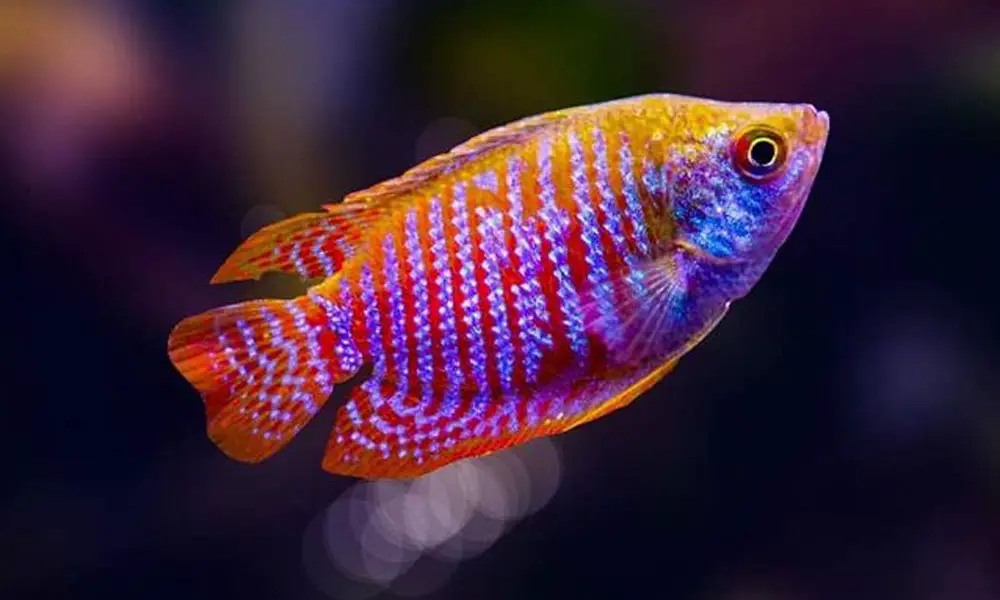
Like Honey Gouramis, Dwarf Gouramis are very popular and readily available everywhere. These two species of Gouramis are hands down the favorites of the hobby.
Dwarf Gouramis are larger than Honey Gouramis and can reach 3 inches (7.6 cm). They tend to be more aggressive than honeys and have a deeper body shape.
A pair of dwarf gourami is known to swim together at all levels of the aquarium, but the problem is that females are rare in the fish trade because of their dull coloration.
Males have especially brilliant red bodies with stripes and a yellow metallic sheen. Several color morphs of dwarf gourami have been selectively bred, including powder blue, Flame red, or neon blue.
It’s the most common variety found at fish stores, but it may carry a fatal, highly contagious virus called the Dwarf gourami Iridovirus (DGIV). According to recent research, approximately 22% of the commercially available Dwarf Gouramis from East-Asian fish farms are affected by DGIV. [1]. That’s why honey gourami might be a better choice for your 10-gallon tank.
| Scientific Name: | Trichogaster Ialius |
| Common Name: | powder blue gourami, red gourami, sunset gourami |
| Origin: | India, West Bengal, Assam, and Bangladesh |
| Size: | 3 inches (7.6 cm) |
| Social: | Peaceful |
| pH: | 6.0 – 7.5 |
| Temperature: | 72 to 82 F (22 to 28 C) |
| KH: | 4 – 10 dKH |
| Diet: | Omnivore |
Sparkling Gourami (Trichopsis pumila)

Also known as pygmy gourami or dwarf croaking gourami, sparkling Gourami is less commonly seen for sale in fish stores.
As its name suggests, these small fish show so many vibrant colors and patterns that it looks like they are covered with a metallic sheen or glitter. Unlike most gourami species with a flat, oval-shaped body, this one has a slightly elongated body and a pointed head.
As for size, they typically stay smaller than 1.5 inches (3.5 cm) when fully grown. Therefore, Sparkling gouramis are well suited to small and community aquariums.
These gouramis are very easy to care for, highly adaptable, and do well with a wide range of water conditions. This fish prefers being in small groups in planted tanks, but in a 10-gallon fish tank, it’s best to keep a pair.
| Scientific Name: | Trichopsis pumila |
| Common Name: | Sparkling Gourami, pygmy gourami, dwarf croaking gourami |
| Origin: | Laos, Vietnam, Cambodia, and Thailand |
| Size: | 1.5 inches (3.5 cm) |
| Social: | Peaceful |
| pH: | 6.0 – 7.5 |
| Temperature: | 72 to 82 F (22 to 28 C) |
| KH: | 4 – 8 dKH |
| Diet: | Omnivore |
Betta (Betta splendens)
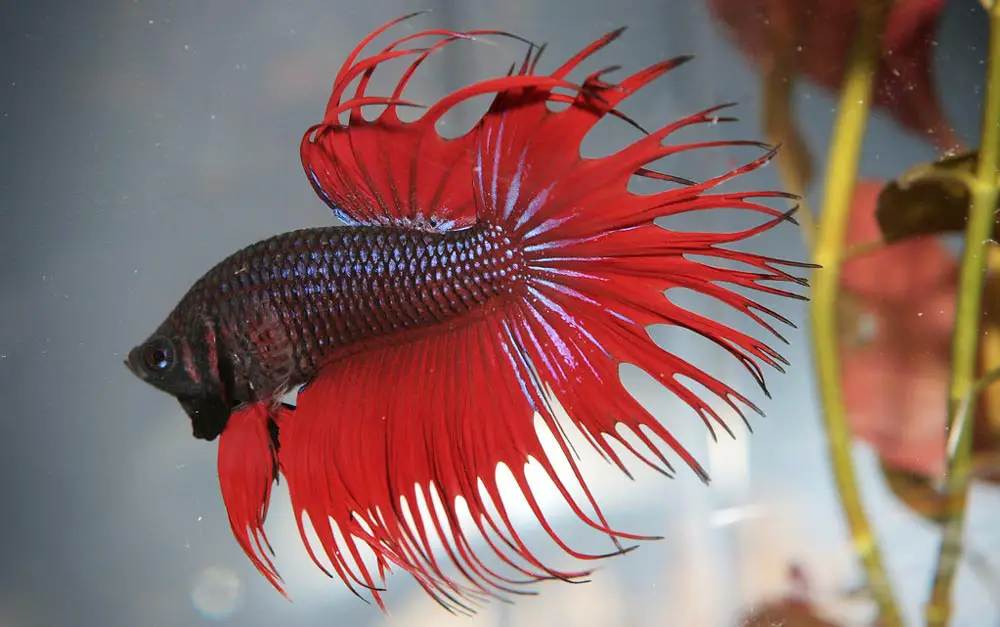
Although bettas and gouramis have the reputation as the two most commonly kept pet fish that are appropriate for small spaces, many people think bettas are a much better centerpiece fish for a 10-gallon tank.
Bettas are brighter in color and have longer fins which make them more visually appealing. Plus, they aren’t as timid and can be more active than gouramis.
However, don’t forget that bettas are much more aggressive due to their territorial nature. If you keep multiple males in one tank, it can lead to aggression. For a 10-gallon aquarium, we suggest keeping just one male betta.
| Scientific Name: | Betta splendens |
| Common Name: | Betta, siamese fighting fish |
| Origin: | Cambodia, Thailand |
| Size: | 3 inches (7.5 cm) |
| Social: | Aggressive |
| pH: | 6.8 – 7.4 |
| Temperature: | 75 to 86 F (24 to 30 C) |
| KH: | 0 – 20 dKH |
| Diet: | Omnivore |
Scarlet Badis (Dario dario)
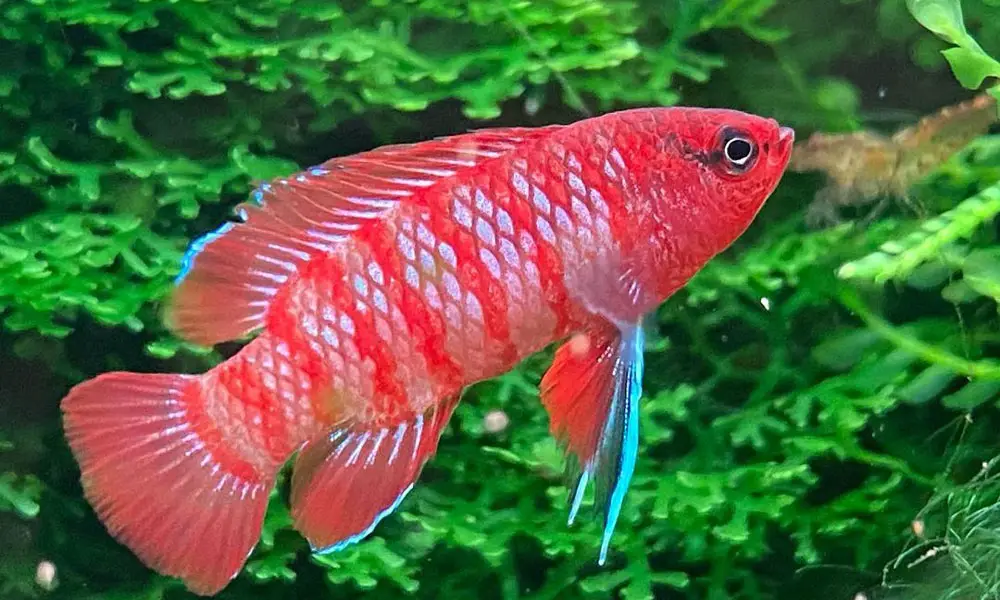
Scarlet badis are aptly named for their bright red coloration. They are one of the smallest known percoid fish species and one of the micropredators, feeding on zooplankton, small crustaceans, worms, and insect larvae in their natural habitat.
Usually, a group of scarlet badis can make a visual contrast against the green of the living plants, creating an eye-catching display as they swim to and fro in the tank.
These fish reach a maximum size of 1.2 inches (3 cm). Given the fact that scarlet badis stay small and can be shy, so choose their tankmates accordingly.
Males feature more vibrant red than females, whereas females remain dull. As a result, females can be difficult to find but are relished by experienced breeders.
| Scientific Name: | Dario dario |
| Common Name: | Scarlet dadis, rainbow badis, scarlet gem badis, gem badis |
| Origin: | India |
| Size: | 1.2 inches (3 cm) |
| Social: | Peaceful |
| pH: | 6.5 – 7.5 |
| Temperature: | 73 to 79F (23 to 26C) |
| KH: | 10 – 15 dKH |
| Diet: | Omnivore |
Peacock Gudgeon (Tateurndina ocellicauda)
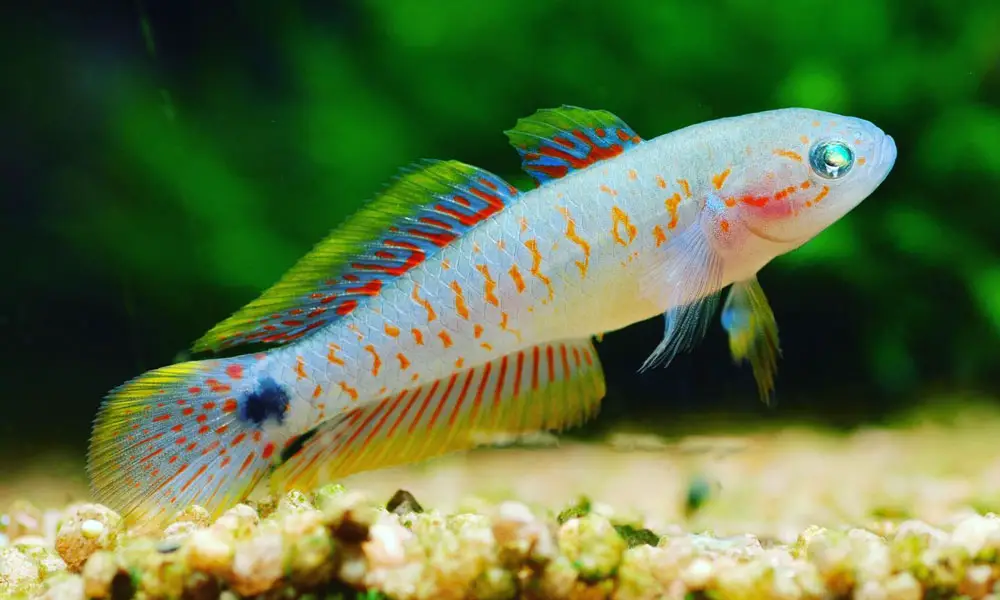
Hailing from the eastern part of Papua New Guinea, these little fish is one of the best beginner fish. They are very attractive, unique, and beautiful, and it’s not hard to see why they are beloved among aquarists.
Peacock gudgeons are pleasing fish that come in a variety of bright colors. The body consists of a colorful mix of pink, yellow, blue, and black hues arranged in intricate patterns.
Not only do they exhibit some beautiful colors, but taking care of them is a simple task. They’re not fussy and do well in community tanks, as well as a species-only tank where focus is put on the plants.
| Scientific Name: | Tateurndina ocellicauda |
| Common Name: | Peacock Gudgeon |
| Origin: | Eastern Papua New Guinea |
| Size: | 3.0 inches (7.5 cm) |
| Social: | Peaceful |
| pH: | 6.0 – 7.2 |
| Temperature: | 73 to 79F (23 to 26C) |
| KH: | 0 – 15 dKH |
| Diet: | Omnivore |
Gardneri Killifish (Fundulopanchax gardneri)
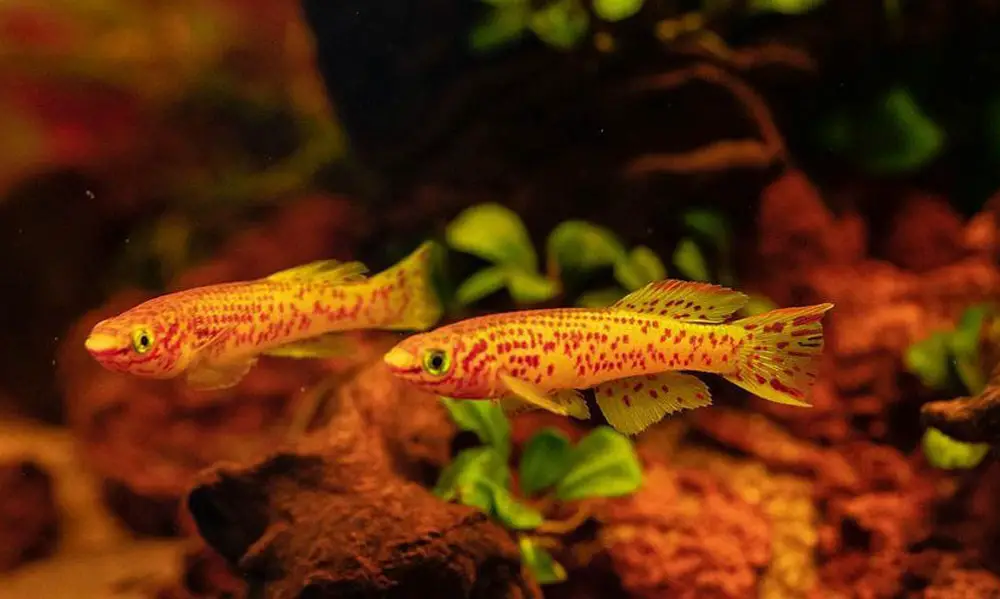
Another fairly new and unique fish in the trade, the gardneri killifish has very striking and bright coloring. This fish hails from Nigeria and Cameroon.
These fish are sexually dimorphic. Males can be easily identified by their bright coloration and tinted dorsal, anal, and caudal fins. Females will usually have a duller color and stay smaller than males.
Because this is a somewhat timid fish, it’s best to be maintained in a species-only setup, with two or more females to every male. They also enjoy lots of plants, so a heavily planted tank with softer water would be ideal for these fish.
| Scientific Name: | Fundulopanchax gardneri |
| Common Name: | Gardneri Killifish |
| Origin: | Africa |
| Size: | 2.5 inches (6.3 cm) |
| Social: | Peaceful |
| pH: | 6.0 – 7.5 |
| Temperature: | 73 to 79F (23 to 26C) |
| KH: | 5 – 8 dKH |
| Diet: | Carnivore |
Shell Dwellers
View this post on Instagram
If you are up for the challenge, shell dwellers from Lake Tanganyika can make a centerpiece for your 10-gallon tank. These fish are beautiful and fun to watch but may require special care to keep them healthy in captivity.
What makes shell-dwelling cichlids unique is that these tiny fighters never stop trying to build their own shells for protection. Tanks should be set up with lots of clean and empty snail shells, as well as a mix of rocks and sand substrate.
They are among the smallest cichlids in the world, reaching a maximum size of 2.5 inches (6 cm). Despite their size, they are aggressive, some species even fierce. To help them flourish in your aquarium, you must recreate their natural environment as best you can.
| Species | Size |
|---|---|
| Neolamprologus brevis | 2.4 inches (6 cm) |
| Neolamprologus hecqui | 3.1 inches (8 cm) |
| Neolamprologus multifasciatus | 1.8 inches (4.5 cm) |
| Lamprologus ocellatus | 2.3 inches (5.8 cm) |
Pea Puffer (Carinotetraodon travancoricus)
View this post on Instagram
While the Pea Puffer, also called Dwarf Puffer, Bumblebee Puffer, and Pygmy Puffer, is possibly the cutest fish on our list. Few people can resist the small size and cute appearance of a pufferfish once they’ve seen one.
However, don’t let the cute little face fool you— they can be feisty and are notorious for nipping the fins of other tankmates, even against their own kind. For this reason, it’s best to keep them in a species-only setup.
Since these critters are carnivorous, you should not keep them with any invertebrates as they will likely attempt to eat them. For a 10-gallon nano tank, you can just keep a single dwarf puffer to ensure a healthy and stress-free environment.
| Scientific Name: | Carinotetraodon travancoricus |
| Common Name: | Pea Puffer, Dwarf Puffer, Bumblebee Puffer, Malabar Puffer, Pygmy Puffer |
| Origin: | India |
| Size: | 1 to 1.5 inches |
| Social: | Aggressive |
| Tank Level: | Mid to Top |
| pH: | 7.0 – 8.0 |
| Temperature: | 72 to 82F (22 to 28C) |
| KH: | 5 – 15 dKH |
| Diet: | Carnivore |
The Most Common Pitfall: Starting Too Small
Whether you’re establishing your first aquarium or assisting a child with starting an aquarium, the most common mistake is to purchase or accept a tank that is too small.
With those “plug and play” 10-gallon tanks that are readily available in every pet shop, it may be appealing to go small. However, a small aquarium means small water volume and biofiltration capacity, so a tiny change in key water parameters, like pH, water temp, or ammonia level, can easily become a major problem and leave no room for error.
On the other hand, if you’re limited to tanks under 10 gallons, then you don’t have many stocking options since most centerpiece fish require more room. Bettas and Gouramis are your best bets.
The most often recommended tank size for beginners is a 20-gallon aquarium, which has sufficient volume, offers plenty of room for centerpiece fish, and gives you more flexibility with stocking.
Poll
[socialpoll id=”2884618″]Time To Hit the Store!
We hope we can add more fish to this list, but the limited size of a 10-gallon tank really restricts us in that regard.
We’d love to know what centerpiece fish you decided on and how it’s doing! Also, if there are any centerpiece fish that you think we should add to the list- let us know in the comments! We’d love to hear your thoughts.
Until next time!
Article Sources:
- Detection of dwarf gourami iridovirus (Infectious spleen and kidney necrosis virus) in populations of ornamental fish prior to and after importation into Australia, with the first evidence of infection in domestically farmed Platy (Xiphophorus maculatus) 2015.09.008
